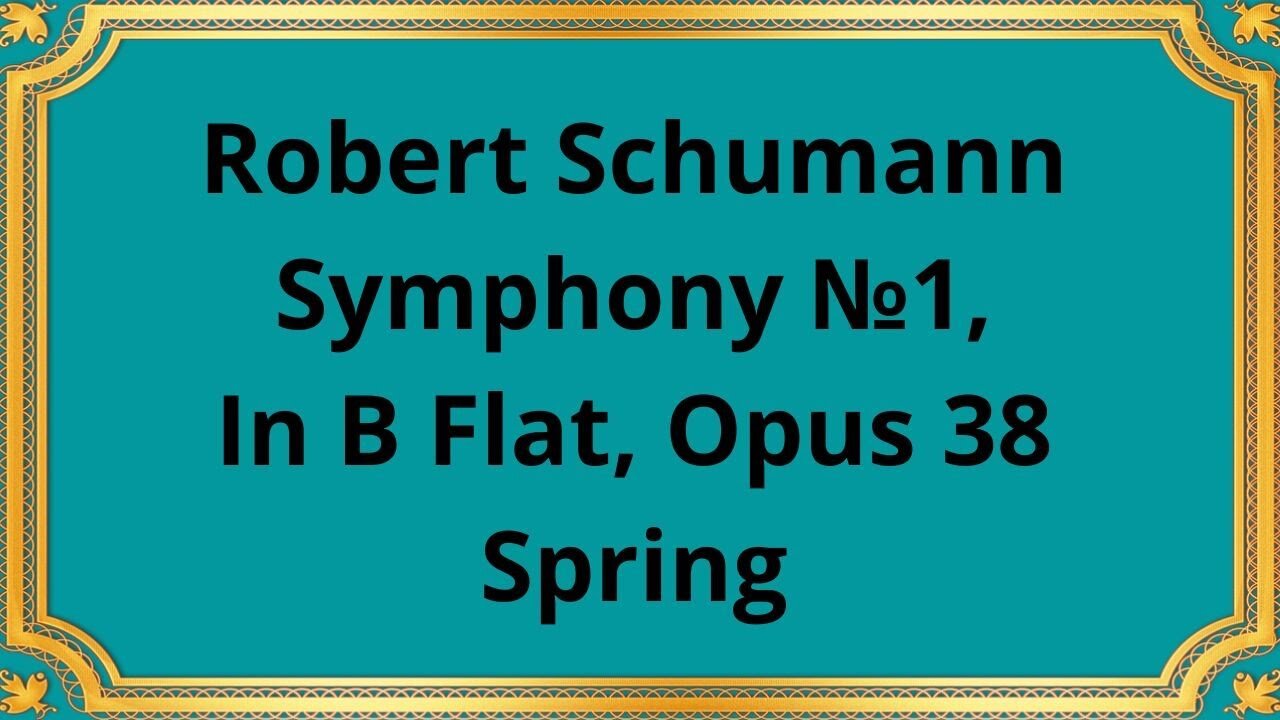Premium Only Content

Robert Schumann Symphony №1, In B Flat, Opus 38 Spring
#RobertSchumann #SymphonyNo1 #BFlat #Opus38 #Spring #ClassicalMusic #MusicalComposition #Symphony #MusicPerformance #MusicHistory #MusicAppreciation
Robert Schumann's Symphony No. 1 in B Flat, Opus 38, commonly referred to as the "Spring Symphony," is a vibrant and uplifting composition that encapsulates the essence of the Romantic era. Composed in 1841, this symphony represents a significant milestone in Schumann's career and stands as a testament to his musical genius.
Robert Schumann, a renowned German composer, wrote the "Spring Symphony" during a period of intense creativity. This symphony marked his first attempt at composing for a large orchestra, reflecting his ambition to establish himself as a symphonic composer. The work premiered in Leipzig in 1841, conducted by Felix Mendelssohn, and was met with resounding success.
Schumann's Symphony No. 1 adheres to the traditional four-movement structure commonly found in symphonic compositions:
1. Andante un poco maestoso - Allegro molto vivace: The opening movement begins with a majestic introduction, gradually transitioning into a lively and energetic Allegro. This movement sets the tone for the entire symphony, introducing the vibrant and joyous themes that evoke the essence of spring.
2. Larghetto: The second movement is a lyrical and introspective adagio. It features delicate melodies and lush harmonies, creating a serene and contemplative atmosphere. This movement showcases Schumann's ability to evoke a range of emotions within a symphonic framework.
3. Scherzo: Molto vivace - Trio I - Trio II: The third movement is a lively scherzo, characterized by its rhythmic energy and playful melodies. It represents the liveliness and exuberance of springtime. The contrasting trio sections provide moments of respite, adding depth and variety to the movement.
4. Allegro animato e grazioso: The final movement is a spirited and joyful finale, bursting with energy and enthusiasm. It features spirited melodies, intricate counterpoint, and a sense of forward momentum. This movement encapsulates the triumphant and celebratory spirit of spring.
Schumann's Symphony No. 1 is characterized by its lush harmonies, expressive melodies, and skillful orchestration. The composition demonstrates Schumann's mastery of thematic development, as motifs introduced in the first movement recur throughout the symphony, creating a sense of unity and coherence. The symphony also showcases Schumann's use of contrasting dynamics, textures, and instrumental colors to evoke a wide range of emotions.
Conclusion:
Robert Schumann's Symphony No. 1 in B Flat, Opus 38, "Spring Symphony," is a powerful and evocative work that captures the essence of renewal and hope associated with the arrival of spring. Its vibrant melodies, lush harmonies, and skillful orchestration make it a significant contribution to the symphonic repertoire of the Romantic era. This masterpiece continues to inspire and uplift audiences, serving as a testament to Schumann's enduring legacy as a composer and his ability to encapsulate the human experience through music.
You have the opportunity to support the channel:
https://destream.net/live/RadSiarAl/donate
https://www.buymeacoffee.com/6355radsiaral
-
 22:54
22:54
Classical music_Music Inspiration
6 days agoLudwig van Beethoven Quartet No. 6 in B-flat major, Op. 18 No. 6
252 -
 10:47
10:47
Nikko Ortiz
18 hours ago15 Seconds Of Fame Gone WRONG...
114K14 -
 14:47
14:47
GritsGG
1 day agoRumble Tournament Dubular! Rebirth Island Custom Tournament!
76.2K5 -
 1:36:05
1:36:05
Side Scrollers Podcast
20 hours agoStreamer ATTACKS Men Then Cries Victim + Pronoun Rant Anniversary + More | Side Scrollers
85.2K13 -
 LIVE
LIVE
Lofi Girl
2 years agoSynthwave Radio 🌌 - beats to chill/game to
297 watching -
 42:55
42:55
Stephen Gardner
1 day ago🔥Trump’s SURPRISE Move STUNS Everyone - Democrats PANIC!
108K128 -
 1:37:19
1:37:19
Badlands Media
18 hours agoBaseless Conspiracies Ep. 148: The Delphi Murders – Secrets, Setups, and Cover-Ups
54.7K21 -
 5:59:05
5:59:05
SpartakusLIVE
12 hours ago#1 MACHINE Never Stops The GRIND || LAST Stream UNTIL Friday
158K5 -
 28:36
28:36
Afshin Rattansi's Going Underground
1 day agoDoug Bandow: ENORMOUS DAMAGE Done to US’ Reputation Over Gaza, Trump ‘Easily Manipulated’ by Israel
42K38 -
 2:45:13
2:45:13
Barry Cunningham
18 hours agoCBS CAUGHT AGAIN! CHICAGO A MESS! LISA COOK IS COOKED AND MORE LABOR DAY NEWS!
128K54